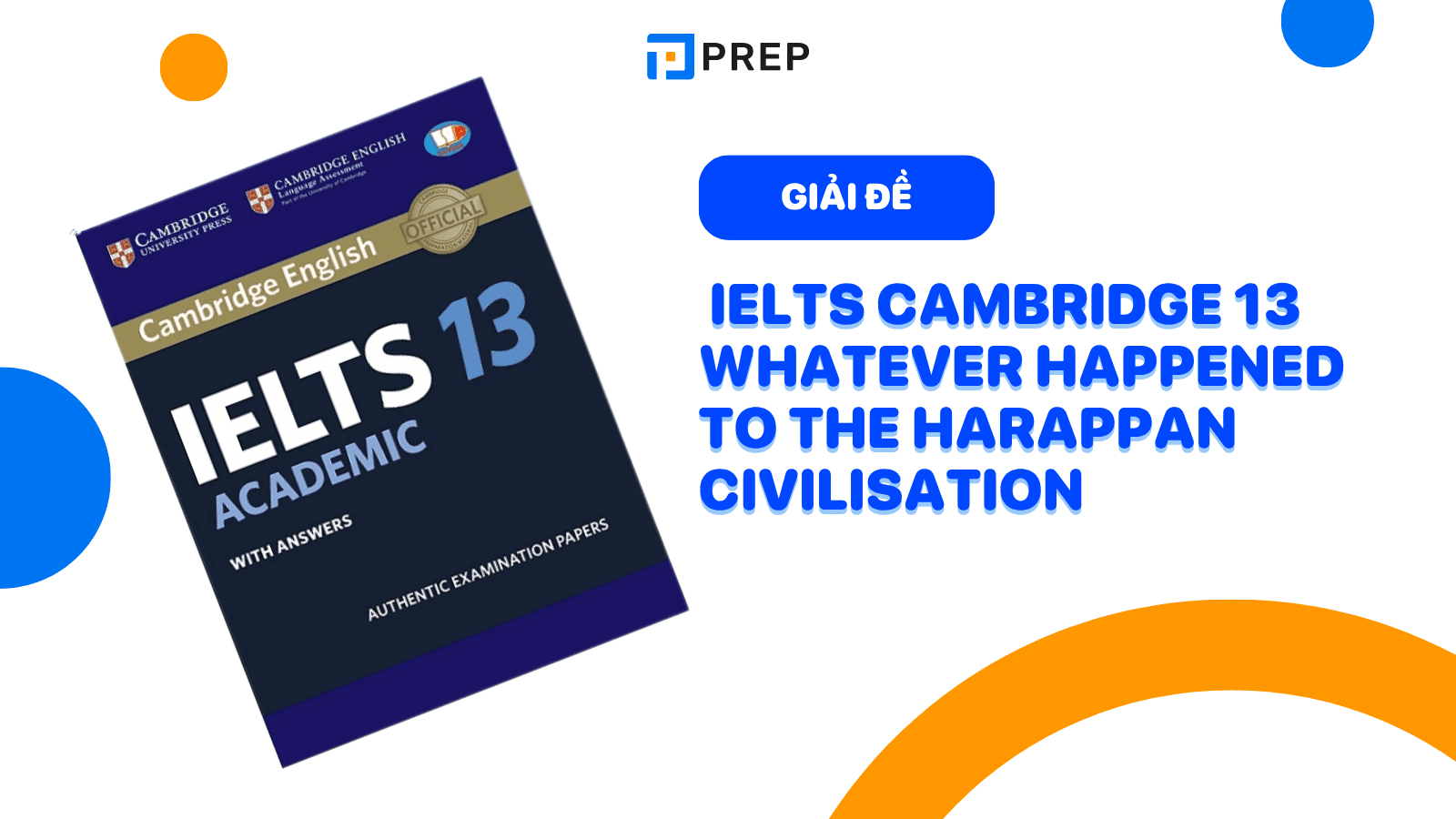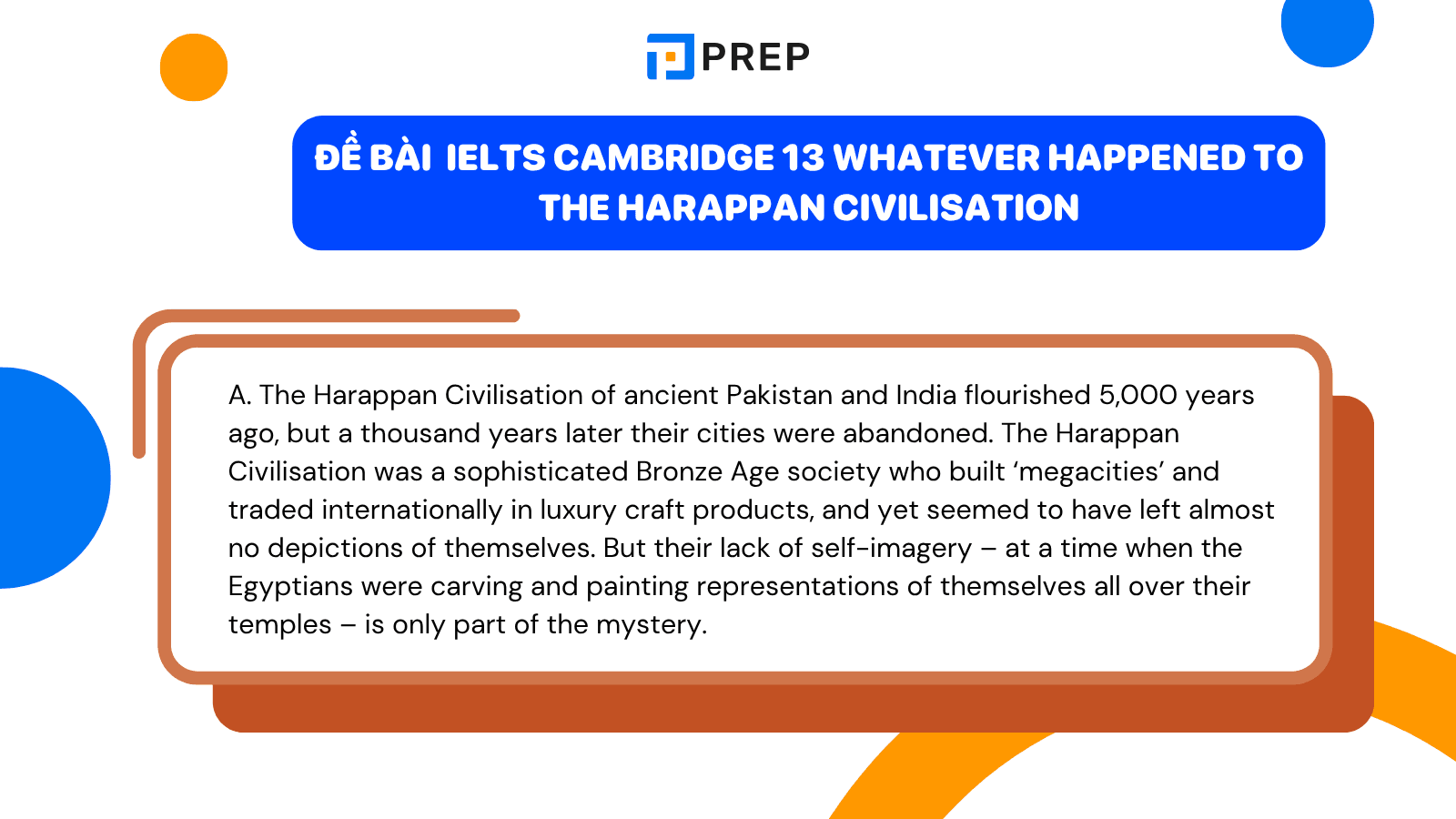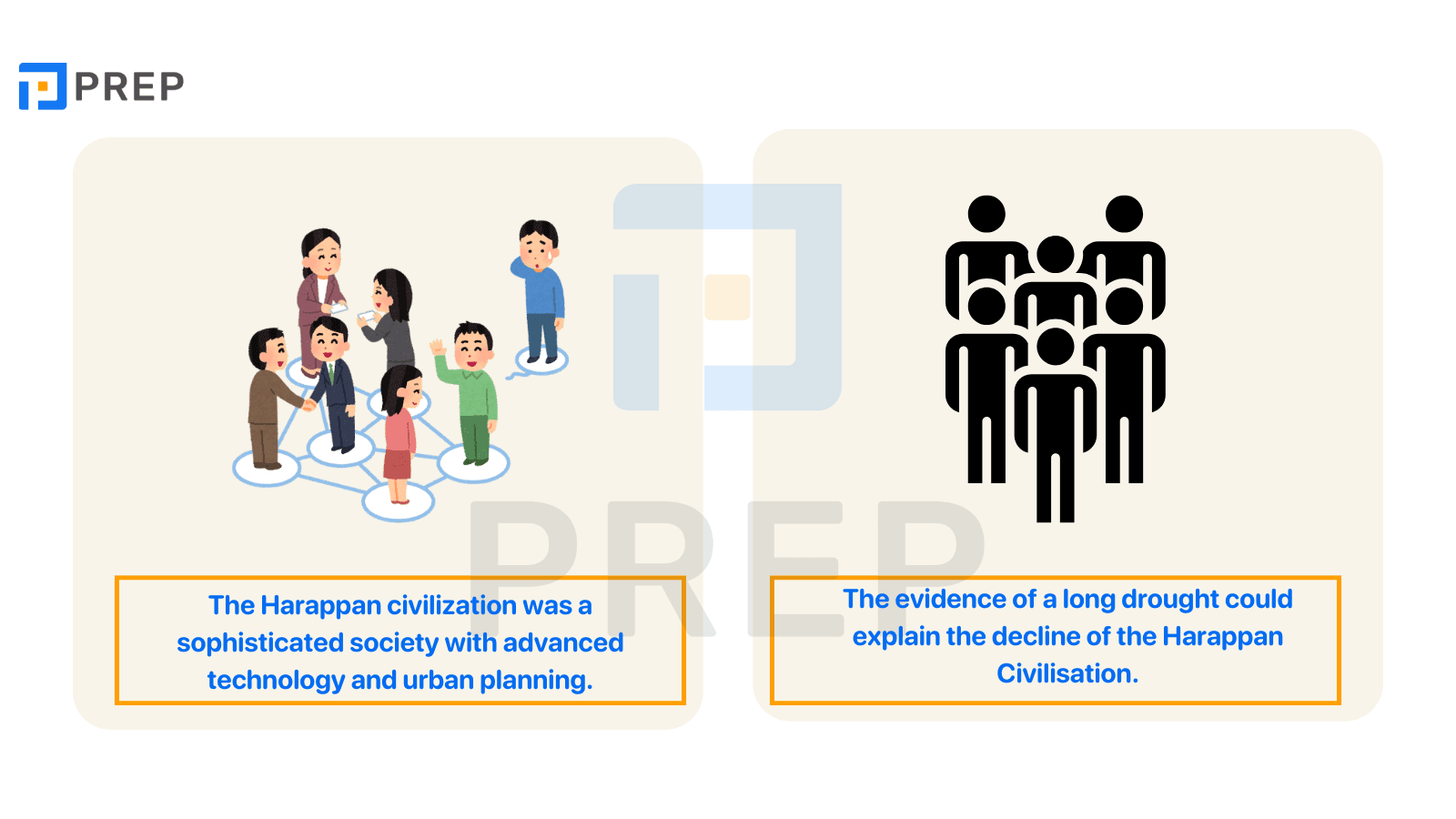Đề bài và đáp án chi tiết bài đọc IELTS Cambridge 13 Whatever happened to the Harappan Civilisation
Bài đọc Whatever happened to the Harappan Civilisation trong IELTS Cambridge 13 là một passage thuộc chủ đề khảo cổ học và lịch sử. Passage sử dụng nhiều thuật ngữ học thuật, thông tin nghiên cứu khoa học và các giả thuyết lịch sử, đòi hỏi người học phải có khả năng đọc hiểu sâu, nhận diện cấu trúc lập luận và phân tích thông tin suy luận. Trong bài viết này, chúng ta sẽ cùng xem đề bài, đáp án chuẩn, và giải thích chi tiết cho từng câu hỏi, giúp bạn nắm vững kỹ năng đọc các bài học thuật phức tạp và tự tin hơn khi chinh phục band điểm cao phần Reading IELTS nhé!

I. Đề bài IELTS Cambridge 13 Whatever happened to the Harappan Civilisation?
Whatever happened to the Harappan Civilisation?
New research sheds light on the disappearance of an ancient society
A. The Harappan Civilisation of ancient Pakistan and India flourished 5,000 years ago, but a thousand years later their cities were abandoned. The Harappan Civilisation was a sophisticated Bronze Age society who built ‘megacities’ and traded internationally in luxury craft products, and yet seemed to have left almost no depictions of themselves. But their lack of self-imagery – at a time when the Egyptians were carving and painting representations of themselves all over their temples – is only part of the mystery.
B. ‘There is plenty of archaeological evidence to tell us about the rise of the Harappan Civilisation, but relatively little about its fall,’ explains archaeologist Dr Cameron Petrie of the University of Cambridge. ‘As populations increased, cities were built that had great baths, craft workshops, palaces and halls laid out in distinct sectors. Houses were arranged in blocks, with wide main streets and narrow alleyways, and many had their own wells and drainage systems. It was very much a “thriving” civilisation.’ Then around 2100 BC, a transformation began. Streets went uncleaned, buildings started to be abandoned, and ritual structures fell out of use. After their final demise, a millennium passed before really large-scale cities appeared once more in South Asia.
C. Some have claimed that major glacier-fed rivers changed their course, dramatically affecting the water supply and agriculture; or that the cities could not cope with an increasing population, they exhausted their resource base, the trading economy broke down or they succumbed to invasion and conflict; and yet others that climate change caused an environmental change that affected food and water provision. ‘It is unlikely that there was a single cause for the decline of the civilisation. But the fact is, until now, we have had little solid evidence from the area for most of the key elements,’ said Petrie. ‘A lot of the archaeological debate has really only been well-argued speculation.’
D. A research team led by Petrie, together with Dr Ravindanath Singh of Banaras Hindu University in India, found early in their investigations that many of the archaeological sites were not where they were supposed to be, completely altering understanding of the way that this region was inhabited in the past. When they carried out a survey of how the larger area was settled in relation to sources of water, they found inaccuracies in the published geographic locations of ancient settlements ranging from several hundred metres to many kilometres. They realised that any attempts to use the existing data were likely to be fundamentally flawed. Over the course of several seasons of fieldwork they carried out new surveys, finding an astonishing 198 settlement sites that were previously unknown.
E. Now, research published by Dr Yama Dixit and Professor David Hodell, both from Cambridge’s Department of Earth Sciences, has provided the first definitive evidence for climate change affecting the plains of north-western India, where hundreds of Harappan sites are known to have been situated. The researchers gathered shells of Melanoides tuberculate snails from the sediments of an ancient lake and used geochemical analysis as a means of tracing the climate history of the region. ‘As today, the major source of water into the lake is likely to have been the summer monsoon,’ says Dixit. ‘But we have observed that there was an abrupt change about 4,100 years ago, when the amount of evaporation from the lake exceeded the rainfall – indicative of a drought.’ Hodell adds: ‘We estimate that the weakening of the Indian summer monsoon climate lasted about 200 years before recovering to the previous conditions, which we still see today.’
F. It has long been thought that other great Bronze Age civilisations also declined at a similar time, with a global-scale climate event being seen as the cause. While it is possible that these local-scale processes were linked, the real archaeological interest lies in understanding the impact of these larger-scale events on different environments and different populations. ‘Considering the vast area of the Harappan Civilisation with its variable weather systems,’ explains Singh, ‘it is essential that we obtain more climate data from areas close to the two great cities at Mohenjodaro and Harappa and also from the Indian Punjab.’
G. Petrie and Singh’s team is now examining archaeological records and trying to understand details of how people led their lives in the region five millennia ago. They are analysing grains cultivated at the time, and trying to work out whether they were grown under extreme conditions of water stress, and whether they were adjusting the combinations of crops they were growing for different weather systems. They are also looking at whether the types of pottery used, and other aspects of their material culture, were distinctive to specific regions or were more similar across larger areas. This gives us insight into the types of interactive networks that the population was involved in, and whether those changed.
H. Petrie believes that archaeologists are in a unique position to investigate how past societies responded to environmental and climatic change. ‘By investigating responses to environmental pressures and threats, we can learn from the past to engage with the public, and the relevant governmental and administrative bodies, to be more proactive in issues such as the management and administration of water supply, the balance of urban and rural development, and the importance of preserving cultural heritage in the future.’
Questions 27-31
Reading Passage 3 has eight paragraphs, A-H.
Which paragraph contains the following information?
Write the correct letter, A-H, in boxes 27-31 on your answer sheet.
NB You may use any letter more than once
27. proposed explanations for the decline of the Harappan Civilisation...............
28. reference to a present-day application of some archaeological research findings...............
29. a difference between the Harappan Civilisation and another culture of the same period...............
30. a description of some features of Harappan urban design...............
31. reference to the discovery of errors made by previous archaeologists...............
Questions 32-36
Complete the summary below. Choose ONE WORD ONLY from the passage for each answer. Write your answers in boxes 32-36 on your answer sheet.
Looking at evidence of climate change
Yama Dixit and David Hodell have found the first definitive evidence of climate change affecting the plains of north-western India thousands of years ago. By collecting the 32............... of snails and analysing them, they discovered evidence of a change in water levels in a 33............... in the region. This occurred when there was less 34............... than evaporation, and suggests that there was an extended period of drought.
Petrie and Singh’s team are using archaeological records to look at 35............... from five millennia ago, in order to know whether people had adapted their agricultural practices to changing climatic conditions. They are also examining objects including 36............... , so as to find out about links between inhabitants of different parts of the region and whether these changed over time.
Questions 37-40
Look at the following statements (Questions 38-40) and the list of researchers below. Match each statement with the correct researcher, A, B, C or D. Write the correct letter, A, B, C or D, in boxes 37-40 on your answer sheet.
NB You may use any letter more than once.
List of Researchers
A. Cameron Petrie
B. Ravindanath Singh
C. Yama Dixit
D. David Hodell
37. Finding further information about changes to environmental conditions in the region is vital................
38. Examining previous patterns of behaviour may have long-term benefits................
39. Rough calculations indicate the approximate length of a period of water shortage................
40. Information about the decline of the Harappan Civilisation has been lacking................

II. Đáp án bài đọc Whatever happened to the Harappan Civilisation
Tham khảo đáp án bài đọc:
27. C
28. H
29. A
30. B
31. D
32. shells
33. lake
34. rainfall
35. grains
36. pottery
37. B
38. A
39. D
40. A
III. Giải thích đáp án chi tiết Whatever happened to the Harappan Civilisation
Questions 27-31
27. Proposed explanations for the decline of the Harappan Civilisation
Đáp án: C
Paragraph C đưa ra một số giả thuyết về sự suy tàn của nền văn minh Harappan, bao gồm thay đổi dòng chảy của các con sông, thiếu tài nguyên, xung đột và thậm chí biến đổi khí hậu.
28. Reference to a present-day application of some archaeological research findings
Đáp án: H
Paragraph H đề cập đến cách mà nghiên cứu khảo cổ học hiện tại có thể ứng dụng vào việc quản lý tài nguyên nước, phát triển đô thị và bảo tồn di sản văn hóa trong tương lai.
29. A difference between the Harappan Civilisation and another culture of the same period
Đáp án: A
Paragraph A so sánh nền văn minh Harappan với nền văn minh Ai Cập, đặc biệt về việc người Harappa không để lại hình ảnh tự họa như người Ai Cập, mặc dù cả hai nền văn minh đều phát triển mạnh mẽ.
30. A description of some features of Harappan urban design
Đáp án: B
Paragraph B mô tả các đặc điểm của thiết kế đô thị ở Harappa, chẳng hạn như các khu phố, các đường phố rộng và hẻm nhỏ, các công trình tắm công cộng và hệ thống cấp thoát nước.
31. Reference to the discovery of errors made by previous archaeologists
Đáp án: D
Paragraph D nói về việc nhóm nghiên cứu của Petrie và Singh phát hiện những sai sót trong các nghiên cứu trước đây, đặc biệt là vị trí sai lệch của các khu định cư cổ đại.
Questions 32-36
32. Shells
Đáp án này được tìm thấy trong Paragraph E, nơi Dixit và Hodell thu thập vỏ của loài ốc Melanoides tuberculate để phân tích dấu hiệu của sự thay đổi khí hậu.
33. Lake
Paragraph E cũng mô tả việc phân tích các mẫu từ một hồ cổ đại ở khu vực Harappa để xác định sự thay đổi trong các điều kiện khí hậu.
34. Rainfall
Trong Paragraph E, Dixit và Hodell xác định rằng sự thay đổi trong mức độ nước của hồ là do lượng mưa ít hơn lượng bốc hơi, cho thấy một thời kỳ hạn hán.
35. Grains
Paragraph G miêu tả nhóm nghiên cứu của Petrie và Singh đang phân tích các loại ngũ cốc được trồng cách đây 5.000 năm để hiểu về việc người Harappa có thể đã thích nghi với điều kiện khí hậu thay đổi như thế nào.
36. Pottery
Cũng trong Paragraph G, nhóm nghiên cứu kiểm tra các loại đồ gốm của người Harappa để tìm ra các sự liên kết giữa các khu vực khác nhau và sự thay đổi trong các kiểu văn hóa vật chất.
Questions 37-40
37. Finding further information about changes to environmental conditions in the region is vital
Đáp án: B
Paragraph F nói về tầm quan trọng của việc tìm kiếm thêm dữ liệu khí hậu để hiểu rõ hơn về các điều kiện môi trường thay đổi và ảnh hưởng của chúng đến các nền văn minh khác nhau, đặc biệt là Harappa.
38. Examining previous patterns of behaviour may have long-term benefits
Đáp án: A
Paragraph H nói về việc nghiên cứu các phản ứng của các xã hội trong quá khứ đối với các thay đổi môi trường có thể giúp ích trong việc giải quyết các vấn đề môi trường hiện nay.
39. Rough calculations indicate the approximate length of a period of water shortage
Đáp án: D
Paragraph E đề cập đến việc các nhà nghiên cứu đã tính toán được thời gian kéo dài của một đợt hạn hán khoảng 200 năm, ảnh hưởng đến các điều kiện môi trường trong khu vực.
40. Information about the decline of the Harappan Civilisation has been lacking
Đáp án: A
Paragraph C chỉ ra rằng mặc dù có nhiều chứng cứ khảo cổ học về sự phát triển của nền văn minh Harappa, nhưng chúng ta thiếu thông tin vững chắc về sự suy tàn của nền văn minh này.
IV. Từ vựng và cấu trúc hay trong bài cần ghi nhớ
|
Từ / Cụm từ |
Nghĩa |
Ví dụ |
|
Sophisticated |
tinh vi, phức tạp |
The Harappan civilization was a sophisticated society with advanced technology and urban planning. → Nền văn minh Harappa là một xã hội tinh vi với công nghệ và quy hoạch đô thị tiên tiến. |
|
Megacities |
thành phố lớn |
The Harappans built megacities with impressive infrastructures. → Người Harappa xây dựng những thành phố lớn với cơ sở hạ tầng ấn tượng. |
|
Drought |
hạn hán |
The evidence of a long drought could explain the decline of the Harappan Civilisation. → Bằng chứng về một đợt hạn hán kéo dài có thể giải thích sự suy tàn của nền văn minh Harappa. |
|
Archaeological evidence |
bằng chứng khảo cổ |
There is plenty of archaeological evidence that tells us about the rise of the Harappan Civilisation. → Có rất nhiều bằng chứng khảo cổ cho thấy sự thăng hoa của nền văn minh Harappa. |
|
Evaporation |
sự bay hơi |
The evaporation rate exceeded the rainfall during the period of climate change. → Tỷ lệ bay hơi vượt quá lượng mưa trong giai đoạn biến đổi khí hậu. |
|
Settlement |
khu định cư |
They discovered 198 settlement sites previously unknown to researchers. → Họ phát hiện ra 198 khu định cư trước đây chưa được các nhà nghiên cứu biết đến. |
|
Adapt |
thích nghi |
The inhabitants of Harappa might have adapted their farming practices to changing climatic conditions. → Những cư dân của Harappa có thể đã thích nghi các phương thức canh tác của họ với những điều kiện khí hậu thay đổi. |
|
Distinctive |
đặc trưng, riêng biệt |
The pottery found in different regions of Harappa showed distinctive features. → Những đồ gốm tìm thấy ở các khu vực khác nhau của Harappa thể hiện những đặc trưng riêng biệt. |
|
Water stress |
căng thẳng về nguồn nước |
Researchers are trying to determine if the crops grown in Harappa were under extreme water stress. → Các nhà nghiên cứu đang cố gắng xác định liệu các loại cây trồng ở Harappa có chịu căng thẳng về nước cực độ không. |
|
Monsoon |
mùa mưa |
The weakening of the monsoon climate could have caused the drought that led to the decline of the Harappan Civilisation. → Việc mùa mưa suy yếu có thể đã gây ra hạn hán dẫn đến sự suy tàn của nền văn minh Harappa. |

Trên đây là đề bài và đáp án kèm giải thích chi tiết bài đọc IELTS Cambridge 13 Whatever happened to the Harappan Civilisation. Hy vọng tài liệu trên sẽ hữu ích cho bạn trong quá trình luyện thi IELTS.
Học tiếng Anh online dễ dàng hơn với PREP - Nền tảng Học & Luyện thi thông minh cùng AI. Nhờ công nghệ AI độc quyền, bạn có thể tự học trực tuyến ngay tại nhà, chinh phục lộ trình học IELTS, TOEIC, tiếng Anh giao tiếp hiệu quả. Bên cạnh đó, học viên còn có sự hỗ trợ tuyệt vời từ Teacher Bee AI, trợ lý ảo giúp bạn giải đáp thắc mắc và đồng hành 1-1 trong suốt quá trình học tập. Hãy click TẠI ĐÂY hoặc liên hệ HOTLINE 0931428899 để nhận tư vấn chi tiết về các khóa học tiếng Anh chất lượng nhất thị trường!
Tải ngay app PREP để bắt đầu hành trình học tiếng Anh tại nhà với chương trình học luyện thi online chất lượng cao.

Chào bạn! Mình là Hiền Hoàng, hiện đang đảm nhận vai trò quản trị nội dung sản phẩm tại Blog của website prepedu.com.
Với hơn 5 năm tự học các ngoại ngữ như tiếng Anh, tiếng Trung và ôn luyện một số kỳ thi IELTS, TOEIC, HSK, mình đã tự đúc rút được nhiều kinh nghiệm để hỗ trợ hàng nghìn người đang gặp khó khăn trong việc học ngoại ngữ. Hy vọng rằng những chia sẻ phía trên sẽ giúp ích cho bạn trong quá trình tự ôn luyện thi hiệu quả tại nhà!
Bình luận
Nội dung premium
Xem tất cảLộ trình cá nhân hoá
Có thể bạn quan tâm
Kết nối với Prep

MSDN: 0109817671.
Địa chỉ liên hệ: Tòa nhà Vinaconex, 34 Láng Hạ, phường Láng, TP Hà Nội.
Địa chỉ kinh doanh: Lô 21 C2 Khu đô thị Nam Trung Yên, phường Yên Hòa, TP Hà Nội.
Trụ sở: Số nhà 20, ngách 234/35 đường Hoàng Quốc Việt, phường Nghĩa Đô, TP Hà Nội.
Phòng luyện ảo - Trải nghiệm thực tế - Công nghệ hàng đầu.
Hotline: 0931 42 8899.
Trụ sở: Số nhà 20, ngách 234/35 đường Hoàng Quốc Việt, phường Nghĩa Đô, TP Hà Nội.
Giấy chứng nhận hoạt động đào tạo, bồi dưỡng số 1309/QĐ-SGDĐT ngày 31 tháng 07 năm 2023 do Sở Giáo dục và Đào tạo Hà Nội cấp.

























